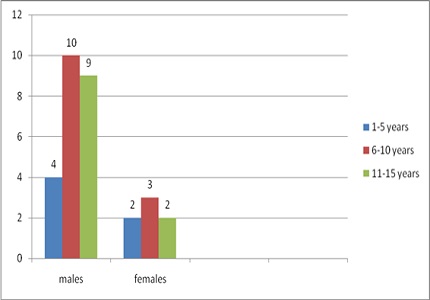Clinical profile of urolithiasis among hospitalized children- a single center study
Abstract
Introduction: Incidence of renal and bladder stones is increasing worldwide and many children presenting with pain abdomen are diagnosed to have renal calculi. There is high rate of recurrence of stones in children if full clearance is not achieved or metabolic evaluation is not performed. We analyzed the clinical profile of the children diagnosed to have Urolithiasis and admitted in pediatric ward of our institute over the period of 2 years (Jan 2015 to Dec 2016).
Methods: We conducted an Observational study done in Children <15 years diagnosed to have Urolithiasis based on Ultrasound findings and admitted in pediatric ward of Velammal medical college hospital, Madurai, Tamilnadu between January 2015 to December 2016. A total of 30 children were enrolled in this study and their demographic details, clinical presentation, investigations and management were analyzed.
Results: Pediatric urolithiasis was more common in boys (75%) with colicky pain abdomen (90%) as the predominant presenting symptom. Most of the children presented during the summer months. They had associated complications like urinary tract infection, hydronephrosis and Pelviureteric junction obstruction. Ureter was the commonest site of urolithiasis (18/30) and most of the children responded to medical management. The children who presented with recurrent symptoms during this study period were evaluated and diagnosed to have some underlying metabolic or genetic disorder.
Conclusion: Rising incidence of renal stones with acute colicky pain in pediatric age group is a worrisome problem as it causes school absenteeism and mental stress to the entire family. Urolithiasis in children needs complete evaluation to rule out underlying metabolic disorder. Complete evaluation of the underlying etiology is essential to prevent recurrence and further complications.
Downloads
References
2. D avid J. Sas. An Update on the Changing Epidemiology and Metabolic Risk Factors in Pediatric Kidney Stone Disease CJASN August 2011 6): (8) 2062-2068; doi:10.2215/CJN.11191210. [PubMed]
3. Akhavan Sepahi M, Heidari A, Shajari A. Clinical manifestations and etiology of renal stones in children less than 14 years age. Saudi J Kidney Dis Transpl 2010; 21(1): 181-4. [PubMed]
4. Valentini RP, Lakshmanan Y. Nephrolithiasis in Children. Adv Chron Kidney Dis 2011; 18(5): 370-5. [PubMed]
5. Shah, A.M., Kalmunkar, S., Punekar, S.V. et al. Spectrum of pediatric urolithiasis in western India. Indian J Pediatr (1991) 58: 543. doi:10.1007/BF02750939. [PubMed]
6. Hernandez JD, Ellison JS, Lendvay TS. Current Trends, Evaluation, and Management of Pediatric Nephrolithiasis. JAMA Pediatr. 2015;169(10):964-970. doi:10.1001/jamapediatrics.2015.1419. [PubMed]
7. Aamer Mehmood Khan, Muhammad Shahid Hussain, Khemchand N Moorani*, Khalid Mehmood Khan Urolithiasis Associated Morbidity in Children. Journal of Rawalpindi Medical College (JRMC); 2014;18(1):73-74.
8. Javed Altaf, Adeel Hyder Arain, Nand Lal Kella, Shafique-ur-Rehman. Chemical Analysis of Urinary Stones and its Locations Associated to Urinary Tract. J Liaquat Uni Med Health Sci. 2013; 12(3): 203-207.
9. Rizvi SA, Naqvi SA, Hussain Z, Hashmi A, Hussain M, Zafar MN. et al. Pediatric urolithiasis: developing nation perspectives. J Urol. 2002;168:1522–5. doi: 10.1097/01.ju.0000028601.63446.51. [PubMed]
10. Pichandi Rajarajan, Raamya Sathish Kumar Motilal Silicate urolithiasis in a paediatric patient; Indian journal of Urology;2017;33(2): 165-166.
11. Angwafo III F.F.a, d • Daudon M.b • Wonkam A.a • Kuwong P.M.c • Kropp K.A. Pediatric Urolithiasis in Sub–Saharan Africa: A Comparative Study in Two Regions of Cameroon.Eur Urol 2000;37:106–111 (DOI:10.1159/000020109) [PubMed]
12. Sharma AP, Filler G. Epidemiology of pediatric urolithiasis. Indian Journal of Urology : IJU : Journal of the Urological Society of India. 2010;26(4):516-522. doi:10.4103/0970-1591.74450.
13. Aaslid A., Tkaczyk M. The clinical course urolithiasis children under 3 years Prog Health Sci 2014,4(1):68-74.
14. Sarkissian A, Babloyan A, Arikyants N, Hesse A, Blau N, Leumann E. Pediatric urolithiasis in Armenia: a study of 198 patients observed from 1991 to 1999. Pediatr Nephrol. 2001 Sep;16(9):728-32.
15. Alpay H, Ozen A, Gokce I, Biyikli N. Clinical and metabolic features of urolithiasis and microlithiasis in children. Pediatr Nephrol. 2009 Nov;24(11):2203-9. [PubMed]
16. Sarica K. Pediatric urolithiasis: etiology, specific pathogenesis and medical treatment. Urol Res. 2006 Apr;34(2):96-101.
17. Acar B, Inci Arikan F, Emeksiz S, Dallar Y. Risk factors for nephrolithiasis in children. World J Urol. 2008 26:627–30. [PubMed]
18. Baştuğ F, Düşünsel R. Pediatric urolithiasis: causative factors, diagnosis and medical management. Nat Rev Urol. 2012 Feb 7;9(3):138-46.
19. Akhavan Sepahi M, Hosini R. Approach and Medical Management of Urinary Tract Stone in Children. Caspian J Pediatr March 2016; 2(1): 86-95.
20. Fowler KA, Locken JA, Duchesne JH, Williamson MR. US for detecting renal calculi with nonenhanced CT as a reference standard. Radiology 2002; 222(1): 109-13. [PubMed]

Copyright (c) 2017 Author (s). Published by Siddharth Health Research and Social Welfare Society

This work is licensed under a Creative Commons Attribution 4.0 International License.


 OAI - Open Archives Initiative
OAI - Open Archives Initiative


